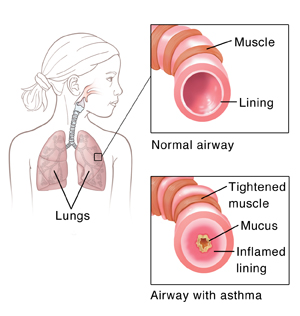Asthma is a condition where the medium and small air passages in the lung go into spasms and block air flow. Inflammation and swelling of the airways cause them to become narrower, make more mucus, and further slow air flow. When a child has asthma, the airways can react to triggers. Some of these triggers are smoke, air pollution, exercise, strong emotions, illnesses such as colds, or pollen. During an acute asthma attack, these factors cause wheezing, coughing, trouble breathing, and chest tightness. Nighttime cough is also common with poorly controlled asthma.
Asthma attacks can be severe. During an attack, quick-acting medicines are used to open the airways. Your child may also take other medicine daily. This is to help reduce inflammation and prevent attacks.
Children with asthma often have allergies. A substance that causes an allergic reaction is called an allergen. Allergens may trigger an asthma attack or make an attack worse. This may occur right after contact, or a few hours later. For this reason, a child with asthma may be referred to an allergist to find out if they have allergies.
Home care
The health care provider may prescribe medicine to help open your child's airways. The medicine may be given through an inhaler with a spacer and face mask. Or the medicine may be given through a machine called a nebulizer. Your child may also be given medicines that come as a pill or liquid. Follow all instructions for giving medicines to your child.
General care
-
It's important to use the inhaler and spacer or nebulizer the correct way. Have your child's health care provider or the pharmacist show you how to use the inhaler or nebulizer correctly.
-
Give all medicines as prescribed. Don't let your child share medicines.
-
Make sure your child has an Asthma Action Plan. It will help you know what to do if your child has an asthma attack. Update your child's plan each year. And update it when you visit the provider who manages your child's asthma.
-
Give a copy of the Asthma Action Plan to daycare providers, babysitters, and school officials. Carry a copy of the Asthma Action Plan when you travel.
-
Make sure all family and household members know about your child's Asthma Action Plan. They need to know how to spot early signs of an asthma attack. They also need to know how to identify and act in an emergency.
-
Teach your child about their asthma and how to manage it. Make sure your child knows what to do if they have an asthma attack.
-
Teach your child how to stay away from allergens or activities that can trigger an asthma attack. Allergens can be tree, grass or weed pollen, dust mites, cockroaches, or animal dander. Things such as running and playing hard, crying, or laughing can also trigger an attack.
-
Have your child wear a medical alert bracelet or necklace.
-
Protect your child from upper respiratory infections or colds. Have them wash their hands often with soap and clean, running water for at least 20 seconds. Keep your child away from people who are sick.
-
Keep your child away from tobacco smoke. Don't let anyone smoke in your home, in your car, or around your child. Don't let your child use e-cigarettes. Stay away from public places where smoking is allowed.
-
Make sure that your child has a healthy diet, gets regular exercise, and keeps doing normal activities. Check with your child's provider about the best types of physical exercise for your child.
-
Ask the provider about keeping your child up-to-date on all vaccines. This includes the flu shot and COVID-19 vaccine.
-
Call the provider right away if your child's symptoms change. Also call if the medicine stops working as well.
Follow-up care
Follow up as advised with an allergist or other specialist. Keep all follow-up appointments with your child's health care provider.
Special note to parents
It can feel scary when your child has trouble breathing. Try to stay calm. Your child may be more anxious if you are anxious. When you're anxious, it can be hard to remember what to do. Think about doing practice runs of asthma attacks. Make yourself go through each step in your child's Asthma Action Plan. The better you know the information in each step, the easier it will be to stay calm during an actual event.
Keep the Asthma Action Plan on your smartphone or an electronic device you use often. Put a paper copy in an easy-to-access place in your home.
Call 911
Call
-
Has lots of trouble breathing and quick-relief medicine isn't helping.
-
Is showing any of the red zone symptoms listed on their Asthma Action Plan.
-
Has trouble staying awake, walking, or talking because of shortness of breath.
-
Uses a peak flow meter as part of an Asthma Action Plan, and it's still in the red zone 15 minutes after using quick-relief inhaler medicine.
-
Has lips or fingernails turning gray, purple, or blue.
When to get medical care
Contact your child's health care provider right away if your child:
-
Has asthma attacks that happen more often or are more severe.
-
Has trouble breathing that isn't relieved by the medicines prescribed for an acute asthma attack.
-
Needs to use a rescue inhaler more than 2 times per week, or as advised by their provider.
-
Has flu symptoms. Children with asthma are at high risk for complications or an asthma attack if they get the flu, sinusitis, or an upper respiratory infection.
Featured in


